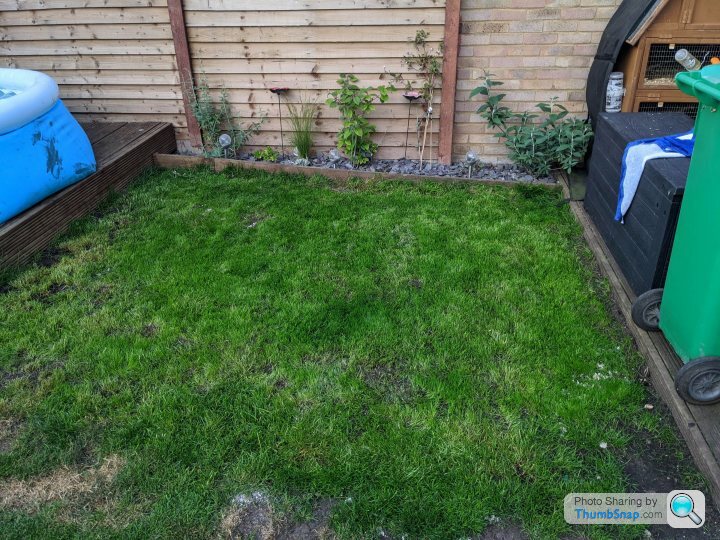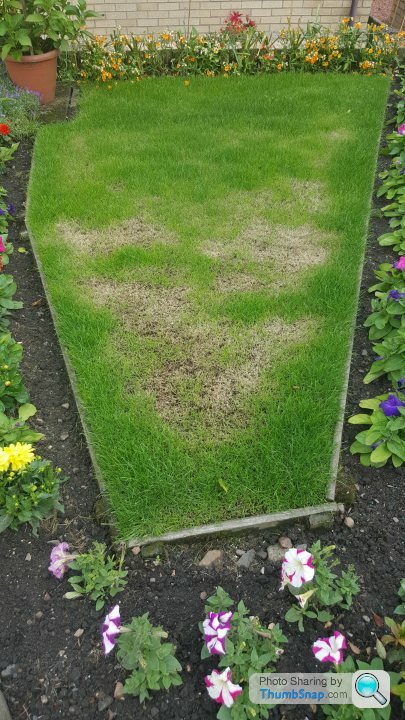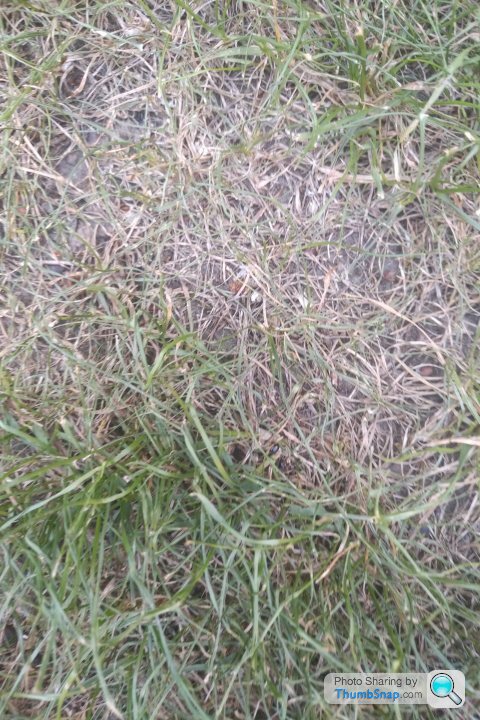2020 Lawn thread
Discussion
ChocolateFrog said:
There's something wrong with my strimmer, it autofed a whole reel out in about half an hour cutting grass. Used some thicker line and manually adjust it but it still breaks off quickly so going to try the cable tie method.
What make/model trimmer?What trimmer line did you use?
For the strimmer users, I thought this might be an interesting comparison.
Whilst it's a convenient tool to use, the strimmer is very brutal in the way it cuts grass and if you want to get the best from your lawn it might be worth considering alternatives.
Grass on the left cut with a strimmer, on the right cut with a scythe:

The cleaner the cut, the faster the grass recovers and the less stress it experiences.
Cut on the same morning four days ago to a similar height, in the foreground the verge was strimmed. Beyond the marker post, no strimmers allowed.

It may be worth swapping the strimmer for shears for edging and border work in more formal lawn areas, at least in times of environmental stress for the grass.
Whilst it's a convenient tool to use, the strimmer is very brutal in the way it cuts grass and if you want to get the best from your lawn it might be worth considering alternatives.
Grass on the left cut with a strimmer, on the right cut with a scythe:

The cleaner the cut, the faster the grass recovers and the less stress it experiences.
Cut on the same morning four days ago to a similar height, in the foreground the verge was strimmed. Beyond the marker post, no strimmers allowed.

It may be worth swapping the strimmer for shears for edging and border work in more formal lawn areas, at least in times of environmental stress for the grass.
jagnet said:
For the strimmer users, I thought this might be an interesting comparison.
Whilst it's a convenient tool to use, the strimmer is very brutal in the way it cuts grass and if you want to get the best from your lawn it might be worth considering alternatives.
Grass on the left cut with a strimmer, on the right cut with a scythe:

The looks like you used too thick a trimmer line or the machine wasn't running fast enough to give a clean cut.Whilst it's a convenient tool to use, the strimmer is very brutal in the way it cuts grass and if you want to get the best from your lawn it might be worth considering alternatives.
Grass on the left cut with a strimmer, on the right cut with a scythe:

What thickness line did you use?
Lanby said:
What thickness line did you use?
Don't know, not my strimmer but it won't have been especially heavy duty  It was definitely being run at speed.
It was definitely being run at speed. That said, even the thinnest strimmer line is, relatively speaking, a very blunt edge. When viewed in slo-mo, you can see how the shredding happens: https://youtu.be/S1opkMO1w4U?t=375
The same type of end damage can be seen when using a rotary mower in need of a sharpen.
jagnet said:
That said, even the thinnest strimmer line is, relatively speaking, a very blunt edge.: https://youtu.be/S1opkMO1w4U?t=375
Correct - but using thick line designed for use on brush will never get a nice finish on grass.
The same type of end damage can be seen when using a rotary mower in need of a sharpen.
Also correct - although there are a huge amount of people that never sharpen or replace a bladeCorrect - but using thick line designed for use on brush will never get a nice finish on grass.
The same type of end damage can be seen when using a rotary mower in need of a sharpen.
If you are using a petrol trimmer; buy decent line, don't use thicker than 2mm for grass and trim lightly - pretend the end inch or so of the line is actually doing the cutting and keep the machine moving
We sell quite a bit of trimmer line each year
jagnet said:
Grass on the left cut with a strimmer, on the right cut with a scythe:

The cleaner the cut, the faster the grass recovers and the less stress it experiences.
... foreground was strimmed. Beyond, no strimmer....

That is very interesting, and not something I had really given much consideration to before. Although I have noticed strimmed edges recovering slower, often they have also been not regularly cut so much longer, and out it fully down to that.
The cleaner the cut, the faster the grass recovers and the less stress it experiences.
... foreground was strimmed. Beyond, no strimmer....

As said, also a good reminder to keep on top of blade sharpening. The mower we inherited (with a spare unfitted blade) was so blunt you could almost not tell it had ever been sharped, near perfect R3 half round radius!
I've been keeping and eye on it as we're planting and cutting new seed, but often let it go a whole year if not several and we are on stoney enough ground it's often well blunt by then.
Not helped when someone chucks some half bricks in the verge I top off twice a year.
Daniel
dhutch said:
That is very interesting, and not something I had really given much consideration to before. Although I have noticed strimmed edges recovering slower, often they have also been not regularly cut so much longer, and out it fully down to that.
Yep it's providing an interesting opportunity to do an impromptu short term side by side comparison. Same grasses, same environmental conditions, same cutting frequency, etc. I'd love to study it over a whole year rather than just a couple of months but annoyingly that's not going to happen this year.stevensdrs said:
dhutch said:
stevensdrs said:
There are a range of products under the 'Aftercut' brand, do you know which you applied? Could the effect areas perhaps have too heavier a dose?I also note you say you water “every night”. This is bad practice, for two reasons. Firstly, watering in the evening allows the grass leaves to stay damp overnight, which will encourage fungal infections like red thread. Instead, water in the morning. Secondly, it is far better to water less frequently but water very thoroughly when you do. This makes the water penetrate deeply into the soil, encouraging the deeper rooted grasses to send their roots downwards and makes them more drought resistant. By watering “little and often” you are only watering the top inch of soil, which will favour the shallow-rooted weed grasses and make your lawn vulnerable to drought.
So, I recommend:
1) Switch to morning waterings, no more than once a week and make it a really good soak.
2) Feed your lawn if you haven’t done so recently. This will speed up growth and cause any red thread affected foliage to grow out.
3) When mowing, collect the clippings if your mower can do that, rather than leaving clippings on the lawn. Normally I recommend leaving clippings from time to time, but if there’s the possibility you’ve got red thread you want to remove the infected material.
Edited to add:
I’m not a fan of “all-in-one” products. It looks to me like your lawn doesn’t have any moss, so why are you applying a product with moss killer in it? And it looks like you have very few (if any) weeds, so why are you applying a product with weed killer in it? You’d be far better off applying just a feed product - they’re way better and there’s hardly any risk of scorching. If you get the odd weed, spot-treat them with a spray bottle of Verdone or similar.
Edited by Dr Mike Oxgreen on Thursday 25th June 08:17
Having watched a few youtube videos of Allen Hayne the lawncare nut and Jake the Lawn Care Kid they seem to be very keen on humic acid and RGS root growth stimulants for liquid feeds.
Anyone got any experience of these in the UK or are they effectively similar to normal fertilisers that LawnSmith etc sells?
I see Pitchcare sells Maxwell HumiMax but at £95 it seems pretty steep!
Anyone got any experience of these in the UK or are they effectively similar to normal fertilisers that LawnSmith etc sells?
I see Pitchcare sells Maxwell HumiMax but at £95 it seems pretty steep!
morfmedia said:
Having watched a few youtube videos of Allen Hayne the lawncare nut and Jake the Lawn Care Kid they seem to be very keen on humic acid and RGS root growth stimulants for liquid feeds.
Anyone got any experience of these in the UK or are they effectively similar to normal fertilisers that LawnSmith etc sells?
I see Pitchcare sells Maxwell HumiMax but at £95 it seems pretty steep!
Version 2 as my first reply got a bit ranty. What problem are you trying to solve with these products? Why do you feel that millions of years of evolution has left the grass in your lawn unable to cope without adding this that and the other to it? Or rather, what have you done to so badly mess up the soil biology in your lawn that you now need to fix it with additives?Anyone got any experience of these in the UK or are they effectively similar to normal fertilisers that LawnSmith etc sells?
I see Pitchcare sells Maxwell HumiMax but at £95 it seems pretty steep!
jagnet said:
morfmedia said:
Having watched a few youtube videos of Allen Hayne the lawncare nut and Jake the Lawn Care Kid they seem to be very keen on humic acid and RGS root growth stimulants for liquid feeds.
Anyone got any experience of these in the UK or are they effectively similar to normal fertilisers that LawnSmith etc sells?
I see Pitchcare sells Maxwell HumiMax but at £95 it seems pretty steep!
Version 2 as my first reply got a bit ranty. What problem are you trying to solve with these products? Why do you feel that millions of years of evolution has left the grass in your lawn unable to cope without adding this that and the other to it? Or rather, what have you done to so badly mess up the soil biology in your lawn that you now need to fix it with additives?Anyone got any experience of these in the UK or are they effectively similar to normal fertilisers that LawnSmith etc sells?
I see Pitchcare sells Maxwell HumiMax but at £95 it seems pretty steep!
I posted this on another lawn forum and a suggestion is that it's 'dry patch' for which I need a wetting agent. Elsewhere everyone is talking about red-thread at the moment so what do people think here?
In just one day the grass has wilted and died in patches across the bottom area of the lawn. Tuesday evening it was all green but after just one day of heat it first turned dark green and then succumbed. The soil underneath is still damp from last week's rain. Is this the dreaded red thread that is spoken about so much these days? It's patchy, not consistent, and you can see other areas that are still fresh and green.
Thoughts?



In just one day the grass has wilted and died in patches across the bottom area of the lawn. Tuesday evening it was all green but after just one day of heat it first turned dark green and then succumbed. The soil underneath is still damp from last week's rain. Is this the dreaded red thread that is spoken about so much these days? It's patchy, not consistent, and you can see other areas that are still fresh and green.
Thoughts?



deckster said:
I get your point, but it's pretty clear that the modern lawn has very little to do with millions of years of evolution, and much to do with aesthetic tastes of Victorian gardeners. There is little that is natural about a flat, monocultured, manicured area of lawn that exists only because we put a huge amount of effort into killing off anything that might interfere with the way it looks.
Even the Victorians appreciated the benefits of not having a monoculture. The only reason that clover is now considered a weed is marketing. You can't have selective weedkillers that don't kill clover, so call clover a weed and bingo, problem solved and lots of weedkiller sales. Oh but no nitrogen fixing now, so why not buy even more fertiliser. And so it goes on.Lots of vested interest in making lawncare seem like a difficult task that needs a whole range of different products to achieve the perfect turf. Lawn care doesn't require huge amounts of effort or products once the basics are right. If it does then something's wrong.
RichB said:
I posted this on another lawn forum and a suggestion is that it's 'dry patch' for which I need a wetting agent. Elsewhere everyone is talking about red-thread at the moment so what do people think here?
Could do with a close up of some of the affected area. I think I can see what looks like fluffiness from fungal threads but it's a bit distant to say for sure.Dr Mike Oxgreen said:
stevensdrs said:
dhutch said:
stevensdrs said:
There are a range of products under the 'Aftercut' brand, do you know which you applied? Could the effect areas perhaps have too heavier a dose?I also note you say you water “every night”. This is bad practice, for two reasons. Firstly, watering in the evening allows the grass leaves to stay damp overnight, which will encourage fungal infections like red thread. Instead, water in the morning. Secondly, it is far better to water less frequently but water very thoroughly when you do. This makes the water penetrate deeply into the soil, encouraging the deeper rooted grasses to send their roots downwards and makes them more drought resistant. By watering “little and often” you are only watering the top inch of soil, which will favour the shallow-rooted weed grasses and make your lawn vulnerable to drought.
So, I recommend:
1) Switch to morning waterings, no more than once a week and make it a really good soak.
2) Feed your lawn if you haven’t done so recently. This will speed up growth and cause any red thread affected foliage to grow out.
3) When mowing, collect the clippings if your mower can do that, rather than leaving clippings on the lawn. Normally I recommend leaving clippings from time to time, but if there’s the possibility you’ve got red thread you want to remove the infected material.
Edited to add:
I’m not a fan of “all-in-one” products. It looks to me like your lawn doesn’t have any moss, so why are you applying a product with moss killer in it? And it looks like you have very few (if any) weeds, so why are you applying a product with weed killer in it? You’d be far better off applying just a feed product - they’re way better and there’s hardly any risk of scorching. If you get the odd weed, spot-treat them with a spray bottle of Verdone or similar.
Edited by Dr Mike Oxgreen on Thursday 25th June 08:17
Gassing Station | Homes, Gardens and DIY | Top of Page | What's New | My Stuff







